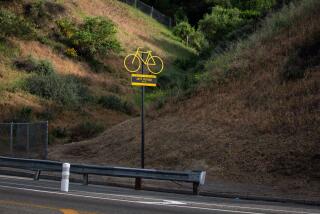Study Shows Danger of Biking, Boozing
- Share via
WASHINGTON — As a drunken bicyclist, Martin Guttenplan thought he was doing fine.
“I was pretty giddy and could hardly ride the bike, but I thought I did a great job,” said Guttenplan, a Florida state transportation planner who got deliberately drunk on scotch to demonstrate how alcohol affects bike riding.
Guttenplan teaches bike education for the League of American Bicyclists, a riders’ group. He was on a test course for a segment of the TV program “Inside Edition.” He had reached a 0.12% blood alcohol level--0.08% can get a person arrested in Florida.
“I moved way out into the lane. I was going on the wrong side of the cones,” Guttenplan recalled of the segment, shot about three years ago. “ . . . But what was most scary was that, in that state, I thought I was doing OK. Any sense of judgment was also affected.”
Guttenplan’s experience is reflected in a new study. Researchers at Johns Hopkins, reviewing 124 Maryland accidents involving cyclists ages 15 years or older, found that 24% of those who died and 9% of those seriously injured had blood alcohol levels of 0.02% or higher.
“The great majority of the ones who had been drinking were above 0.10%, which is the Maryland point at which you are considered to be impaired,” said researcher Susan P. Baker. “The average blood alcohol concentration was 0.18%, which is very, very high.”
Many of the riders in the accidents were pretty far gone, Baker said. At a blood alcohol concentration of 0.18%, “you or I probably would not be able to find our bicycles,” she said. “ . . . If they can ride bicycles with blood alcohol concentrations that high, they are probably pretty serious drinkers.”
Risks of injury rose with the blood alcohol level. At 0.08%, the risk was 20 times the level faced by people with levels below 0.02%.
The researchers compared those cases with 342 other cyclists who were stopped later at the same places and times of day as the accidents. Those riders were given breath tests for blood alcohol.
About 3% of the randomly sampled riders had blood alcohol levels of 0.02% or more. However, the data probably understate the prevalence and danger of drunken biking, said the report in the Feb. 21 issue of the Journal of the American Medical Association. The findings only cover daylight accidents because researchers felt it unsafe to survey at night.
Researchers also found that drunken riders were less likely to wear helmets. Thirty-five percent of the interviewed riders wore helmets, compared with 5% of those in accidents. It is possible that the riders were too impaired to realize they needed a helmet, it said.
Although the study did not examine it, Baker suspected that many of the injured riders had taken to biking because they had lost their drivers’ licenses due to driving under the influence.
A police officer in Boulder, Colo., has found this often to be the case in his area. “I would say maybe 30% are people who don’t have a license because of DUI restrictions,” said Sgt. Rob Bustrom. “They are trying an alternate mode, but they haven’t quit the DUI part of it.”
*
League of American Bicyclists: https://www.bikeleague.org





